Guide to Multimode Fiber: OM1, OM2, OM3, OM4, OM5
We’ve spoken frequently in the past about the difference between single mode and multimode fiber. Multimode fiber can also be divided into 5 grades: OM1, OM2, OM3, OM4, and now OM5.
These multimode fiber types are available for high-speed network installations, and each with a different reach and data-rate capability. With so many options, it can be tough to select the most suitable multimode fiber for your network needs. OM1, OM2, OM3, OM4 and OM5, what exactly makes them different? You may get answer in this article.
Table of Contents
- What is Multimode Fiber?
- How Many Types of Multimode Fiber?
- What’s the Difference between Multimode Fibers?
- Conclusion
- You May Also be Interested
What is Multimode Fiber?
Multimode fiber (MMF) is a type of optical fiber designed to carry multiple light rays or modes simultaneously, each at a marginally different reflection angle inside the optical fiber core.
Multimode fiber is mainly used to transmit across comparatively shorter distances, for example, inside a building or for the campus, as the modes are more likely to disperse over longer extents. The maximum transmission distance for MMF cable is around 550m at the speed of 10Git/s. It can transmit farther at lower data rates, such as going about 2km at 100Mb/s. Another common type of optical fiber is the single-mode fiber, which is used mainly for longer distances.
How Many Types of Multimode Fiber?
Multimode fiber offers five different types of cabling which are OM1, OM2, OM3, OM4, OM5 fibers.
- OM1 Fiber. OM1 fiber typically comes with an orange jacket and have a core size of 62.5 µm. It can support 10 Gigabit Ethernet at lengths of up to 33 meters. It is most commonly used for 100 Megabit Ethernet applications. This type commonly uses a LED light source.
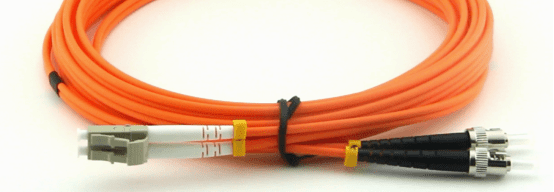
- OM2 Fiber. Likewise, OM2 fiber also comes with an orange jacket and uses a LED light source but with a smaller core size of 50 µm. It supports up to 10 Gigabit Ethernet at lengths up to 82 meters but is more commonly used for 1 Gigabit Ethernet applications.
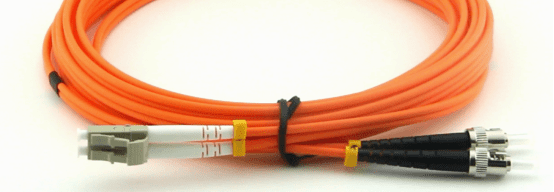
- OM3 Fiber. OM3 fiber comes with an aqua color jacket. Like the OM2, its core size is 50 µm, but the cable is optimized for laser-based equipment. OM3 supports 10 Gigabit Ethernet at lengths up to 300 meters. Besides, OM3 is able to support 40 Gigabit and 100 Gigabit Ethernet up to 100 meters, however, 10 Gigabit Ethernet is most commonly used.
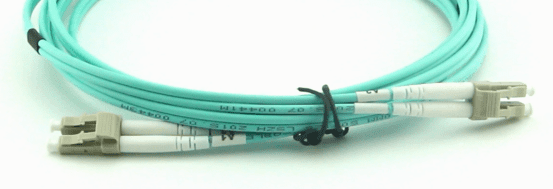
- OM4 Fiber. OM4 fiber is completely backwards compatible with OM3 fiber and its outer sheath is aqua blue or violet. OM4 was developed specifically for VSCEL laser transmission and allows 10 Gig/s link distances of up to 550m compared to 300M with OM3. And it’s able to run 40/100GB up to 150 meters utilizing a MPO connector.
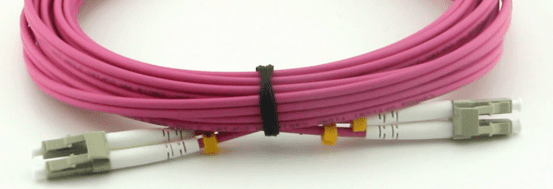
- OM5 Fiber. OM5 fiber is the newest type of multimode fiber, and it is backwards compatible with OM4. It has the same core size as OM2, OM3, and OM4. The color of OM5 fiber jacket was chosen as water green. It is designed and specified to support at least four WDM channels at a minimum speed of 28Gbps per channel through the 850–953 nm window.
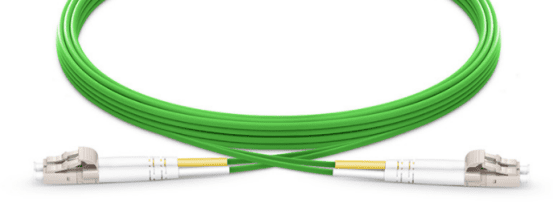
What’s the Difference between Multimode Fibers?
- Physical Difference. Physical difference mainly lies in diameter, jacket color, optical source and bandwidth.
MMF CABLE TYPEDIAMETERJACKET COLOROPTICAL SOURCEBANDWIDTHOM162.5/125µmOrangeLED200MHz*kmOM250/125µmOrangeLED500MHz*kmOM350/125µmAqua BlueVSCEL2000MHz*kmOM450/125µmAqua Blue or VioletVSCEL4700MHz*kmOM550/125µmWater GreenVSCEL28000MHz*km
- Practical Difference. Multimode fibers are able to transmit different distance ranges at various data rate.
MMF CATEGORYFAST ETHERNET1GBE10GBE40GBE100GBEOM12000m275m33m//OM22000m550m82m//OM32000m/300m100m70mOM42000m/550m150m150mOM5//550m150m150m
Conclusion
Due to its high capacity and reliability, multimode fiber is usually used for backbone applications in buildings, and it continues to be the most cost-effective choice for enterprise and data center applications up to the 500–600 meter range. But that doesn’t mean we can replace single mode fiber with multimode fiber cable. When deciding between a single mode fiber and a multimode fiber, it all comes down to the applications you need, the transmission distance you need to cover, and the overall budget you have.
4KEX300-F is a high-end 4K HDMI extender over fiber from AV Access. With a duplex OM3 multi-mode optical fiber cable, it can transport HDMI signals up to 1000ft/300m.
You May Also be Interested
- 2 Types of Fiber Optic Cable: Single Mode vs. Multimode Fiber
- Four Main Benefits of Fiber Optic
- HDMI over Fiber Extender for HDMI Extension
- AV Access Introduces Its New 8K Fiber Optic HDMI Cable for High-Speed A/V Transmission in Home Theater and Gaming Applications
Source: https://www.avaccess.com/blogs/guides/guide-to-multimode-fiber-om1-om2-om3-om4-om5/

